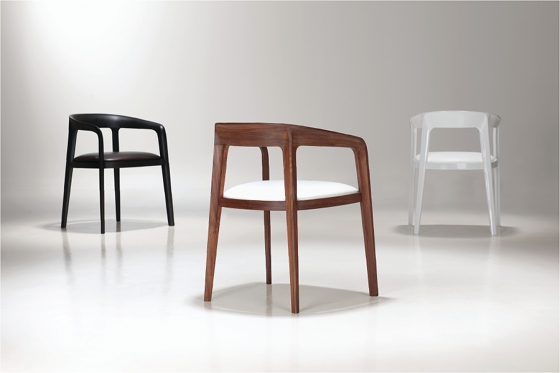Détente Cordiale: when Noé Duchaufour-Lawrance met Bernhardt Design
Text von Simon Keane-Cowell
Zürich, Schweiz
09.10.10
Already a contemporary classic, French designer Noé Duchaufour-Lawrance's 'Corvo' chair for US manufacturer Bernhardt Design is certainly no flash-in-the-pan object to be consumed briefly and then forgotten. Highly considered in terms of its design and production, it invites an equally considered, long-term engagement from the user, one that's as much about emotion as it is utilitarian use. Architonic spent some time with the trained sculptor at this year's London Design Festival, discussing, among other things, his experience of transatlantic collaboration, why he's not a modernist, and the particular commercial – and physical – demands of the American market.
Last time it was nylon stockings and chewing gum. This time a collection of highly considered and rather covetable furniture. Yes, the Americans are back in Britain. Showing in a West End hotel as part of the recent London Design Festival, and in keeping with the ever-growing international profile of the week-long, city-wide event, US manufacturer Bernhardt Design offered visitors a chance to get to know new work by a number of respected designers, including Monica Förster, Jamie Hayón and Noé Duchaufour-Lawrance.
Paris-based designer Noé Duchaufour-Lawrance: 'Often we are close to objects that aren't designed with us in mind'

Paris-based designer Noé Duchaufour-Lawrance: 'Often we are close to objects that aren't designed with us in mind'
×While the designs on show might have been new, the company certainly isn't. Not quite in the same longevity league as, say, Thonet, Bernhardt Design does, nonetheless, have a fair bit of history behind it, having been founded in Oregon in 1889. And the solidity of its business is matched by that of its products, the brand being known for producing pieces that are extremely well crafted. This comes as no surprise when you learn that its founder, John Bernhardt, established the company with the purchase of a saw mill, his intention to manufacture robust solid-oak bedroom furniture. It was first in the 1980s, however, that Bernhardt Design started to commission designers internationally to help amplify its creative voice.
Since then, an impressive list of names have accepted the invitation to work with the American brand, among them Ross Lovegrove, Patrick Jouin, Arik Levy and Patrick Norguet. While in London, Architonic met up with two of Bernhardt Design's current collaborators, Paris-based Noé Duchaufour-Lawrance and Scottish artist and designer Jephson Robb. Here, I talk to the Frenchman, whose resolutely sensual work for such European manufacturers as Ligne Roset and Ceccotti, as well as his interiors projects, like London's Sketch restaurant, have helped established his reputation as a designer with a distinctive, very expressive language.
Noé Duchaufour-Lawrance's 'Corvo' chair for Bernhardt Design
…..
Why did you decide to collaborate with Bernhardt Design and how does the process of working with them differ from working with other manufacturers?
Well, I really liked Bernhardt Design's past work. They produced a chair with Ross Lovegrove (the 'Go' chair from 2000) which was a chair for the new millennium. It was very impressive to do this kind of object at that time. So that was my first interest in the brand. And then I met (the company's president) Jerry Helling. I really think that design is always a question of relations – the way you work with people and the way you can share things. And we had a few conversations, one of which was talking about that there are too many things around, too much design, so we have to do something that's really focused on one thing, on one language. If we are making something together, it is not yet another piece, it's something different, perhaps with a different approach. It doesn't have to be revolutionary, but something on which more energy and more time has been spent.
So how did this collaboration, with its considered approach, actually start?
Jerry asked me to design a chair in wood for the American market, first of all. Something different from all the wooden chairs in the catalogue. The frontier between classic and modern is always something quite strange to do, so that's what I focused on with the 'Corso' chair. The idea was to work on two sides of the object. Many designers work from the front view, but not from the back, for example when the chairs are around a table. So that was how I started drawing the chair, making the drawing from its structure. It was supposed to be a very graphic object. But also very organic at the same time. A double language: bones and flesh, in a way.
We didn't exactly know what technique we were going to use, but finally we decided wood because we realised it was the best way to do this particular piece. With moulding, it would have been incredibly expensive to make. We had to adapt the design to the material, but it's amazing to see how the pieces can be made by hand and how they are all different. They have this touch that makes every chair unique. I love it when people touch objects. We live with them. They shouldn't be aggressive or in contradiction to how we're living.
'A double language of bones and flesh' is how Duchaufour-Lawrance describes the design of his 'Corvo' chair for Bernhardt Design
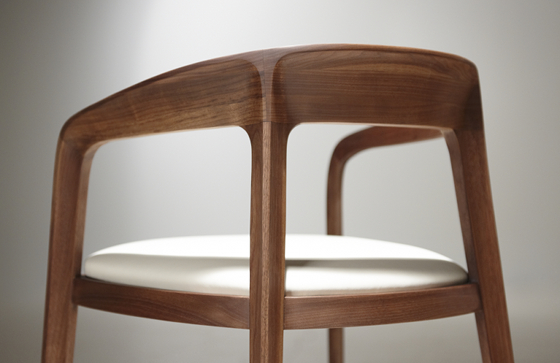
'A double language of bones and flesh' is how Duchaufour-Lawrance describes the design of his 'Corvo' chair for Bernhardt Design
×You've talked in the past about the function of a piece of furniture being more than its practical use. It having an emotional function. How does that sit with this chair, which is so rational, so considered in its design?
It's a question of what you want to express in terms of emotion. How you, as a designer, translate emotion through the design, the drawing, the technique and the material. For me, a designer is someone who draws these things together and really takes them somewhere. Me, I take nature, and the contemplation of nature, as my emotional source. Not in the way that nature is made. But what you feel from nature without having to think about it too much. Emotion. That's what I want to translate in my design. The sensuality of things. When I'm designing I try to find a reference to something that is organic in a way. I think that there has to be a link in today's furniture between us and nature, because urban life makes us so disconnected from nature. The damage has been done. But there's an opportunity in design to make a link with nature, which is the origin of everything. That's what I try to do.
So you're certainly not a modernist.
I'm not. I mean I work with modernism, as I like to place my work in spaces that are made primarily of light and volume. But I think that this period is finished. We have to think about how we are going to use the concrete buildings we have which separate us from the environment. All that man has made in the West are elements that take us away from nature and not try to exclude humans from the general process. Our roots are much more natural than that. Often we are close to objects that aren't designed with us in mind. We are bringing technology where we don't need it. If somewhere in the object the user can see and understand the work and sensitivity in it, but which still fits in a modern environment, then that's important.
Noé Duchaufour-Lawrance's 'Corvo' chair, manufactured by American brand Bernhardt Design. 'Many designers work from the front view, but not from the back,' says Duchaufour-Lawrance. 'The idea was to work on two sides of the object.'
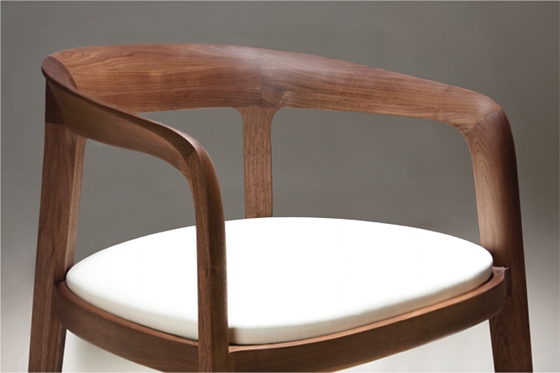
Noé Duchaufour-Lawrance's 'Corvo' chair, manufactured by American brand Bernhardt Design. 'Many designers work from the front view, but not from the back,' says Duchaufour-Lawrance. 'The idea was to work on two sides of the object.'
×Users may connect with those values, they may appreciate them, but do you think they really do this on a conscious level?
Well, I don't think that this can be achieved in just one object. And it certainly works on a less conscious level. But if I can appeal to something that is much more primitive in everybody, more direct, then that's great. Just yesterday, I saw a lady in the showroom touching the chair in a sensual way while talking to someone about something completely unconnected. It was an unconscious, emotional interaction. It's about touch. Everything is made by hand and can be appreciated by hand.
We live in such a highly visual, image-driven society, so perhaps there's a reordering of the hierarchy of senses there...
Well, it's the academy also. Intellect and the rational are given privilege over emotion. We all work in the same way. Now, we stand in front of the fact that we went too far. What do we do now? We can't destroy what we've done. It would be too much of a waste. We have to keep going with what we have.
I think the emotional value of design is more important than ever in this age of hyper-consumption. The more of an emotional connection you have with a piece, the more likely it is you hold onto it for a lot longer, you live with it for a lot longer and don't throw it away.
That's right. I've been through materials that are naturally evocative, like wood, stone and leather, but now I would really like to make something in plastic. To make the same emotional link but to really have to think about the economy of it, about its sustainability. This is a challenge.
Duchaufour-Lawrance's 'Corvo' chairs installed at Haymarket Hotel during the London Design Festival 2010
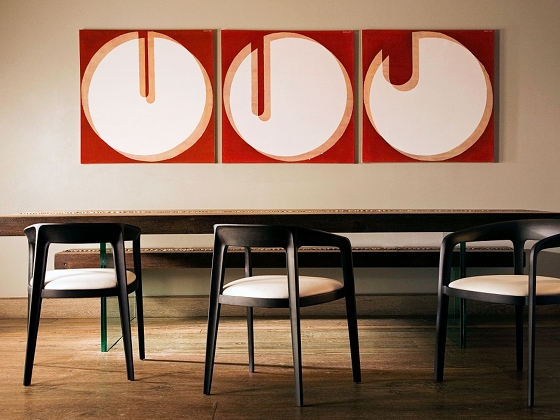
Duchaufour-Lawrance's 'Corvo' chairs installed at Haymarket Hotel during the London Design Festival 2010
×You've designed a number of high-profile interiors. When you're designing a piece of furniture, do you think about the spatial context in which it might appear?
When I'm designing a piece, I always try to project this piece somewhere, making a global environment. When I first designed the 'Manta' desk for Ceccotti, I came to them with a virtual house – images of the house with the furniture inside. The house was made of parts of furniture. And I did a movie, with the objects in the beach. You'd go into the object itself. It became architecture. It was the idea of scale, inspired a bit by the Charles and Ray Eames film 'Powers of Ten'. I really believe in the power of the object in space. And the opposite: space can feed objects. The two are closely related, for sure.
You mentioned that part of this brief was to design a chair for the American market. What does that mean? How does that demand change the creative brief?
Well, it means it musn't be too aggressive. It musn't be too experimental or provocative.
But why is that, do you think?
Because the American market in terms of design is brand new. Relative to the size of the country there are very few design manufacturers. Obviously, Bernhardt Design is one of them. The Americans have been very conservative, but that's evolving. But still, it's a bit like walking on glass. (Laughs.) Which is very delicate. There's also the question of solidity. The American market is very hard in terms of testing. The chair went through something a bit like a torture chamber.
Bernhardt Design chairs on show during the London Design Festival; 'Go' chair by Ross Lovegrove (left), 'Vika' by Monica Förster (middle) and Duchaufour-Lawrance's 'Corvo' (right)
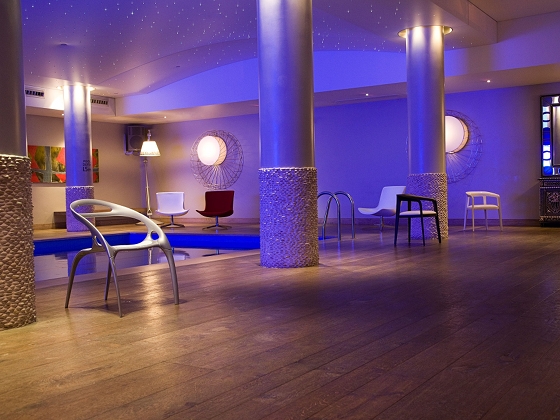
Bernhardt Design chairs on show during the London Design Festival; 'Go' chair by Ross Lovegrove (left), 'Vika' by Monica Förster (middle) and Duchaufour-Lawrance's 'Corvo' (right)
×How much of that is to do with, at the risk of employing a stereotype, more ample American bodies?
(Laughs.) It's one of the things that you do have to consider. You don't design the same chair for the American and Japanese markets.
Here we are in London, Noé, during the design festival. What do you make of UK design culture?
British design culture really is a mix of a lot of different things. There are influences from all over. Mixing things together. French design still seems to follow more of a single line. And there is the issue of taste in France. Experimentation wasn't really at the core of my training in France. I think you do this a lot more in the UK or in the Netherlands. In France, it's much more about doing things well. But I take my inspiration from all over the place. From the landscape, where there is an interaction with the elements. The design scene in Paris is starting to move, for sure. There's something going on. But it's still built on something that is very old.
Thanks very much for talking to us.
.....

